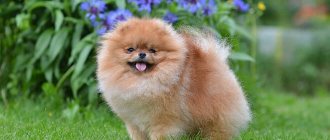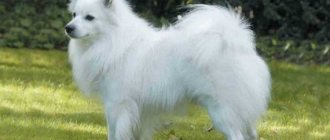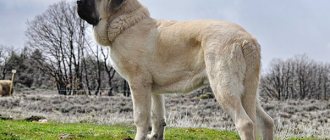There is a beautiful legend that Magi with gifts came to worship the infant Christ, accompanied by three Spitz dogs. The history of the breed is fascinating and sometimes surprising.
The Pomeranian is the funniest and most charming dog of all breeds . Such a tiny representative has high intelligence and a gentle disposition, which allows him to find a common language with children and adults. These are very loyal, unpretentious and vigilant dogs, they love to travel and can easily endure trips . Despite their doll-like appearance and tiny size, Spitz dogs want to be the first in everything and everywhere. Breeders call them “Napoleons” because of their dominance, because they also show their leadership qualities in a dispute with large dogs.
The weight of a dwarf Spitz is only two or three kilograms , and the height at the withers reaches 18-22 cm , so this species belongs to small decorative breeds.
Ancient roots
The appearance of the breed is quite ancient. Swiss turf dogs are recognized as their ancestors. In the 19th century, archaeologists discovered skeletons of domesticated-looking animals. They were found on the site of pile dwellings. The remains partly resembled those of a wolf.
When trying to recreate the appearance, scientists had a completely unexpected discovery. The found skeleton was clearly similar in structure to modern Spitz dogs.
Ancestors of modern Spitz-types
How did German appear?
The variety is not only one of the oldest in Europe, but is also considered the ancestor of most other dog species.
The forefather of the German Spitz is considered to be the turf dog, which existed in the Stone Age.
This particular species belongs to watchdogs, because often used in the service of peasants. Until the 18th century, such animals were considered an economical option for a guard dog and could also perform herding functions.
The German Spitz gained popularity in the 18th century and was subject to various selections by breeders, reducing its size.
Subsequently, the German Spitz became a favorite of the German and English aristocracy. Queen Charlotte's pets were among the first to appear in the circle of the British monarchy. They were quite large and tall, white in color. The popularity of orange and brown colors appeared much later, by the beginning of 1900.
In the 19th century, the popularity of animals reached the United States, where the species was also subjected to selection. After which European and American pets began to differ greatly from each other within the same breed. Currently, a unified breed standard has been developed.
There are several height varieties of this type of dog:
- Wolfspitz or Keeshond, reaches from 23 to 55 cm at the withers;
- Grossspitz (large Spitz), height at the withers from 42 to 50 cm;
- medium Spitz, from 30 to 38 cm;
- small, height from 23 to 29 cm;
- miniature - from 18 to 22 cm.
Different colors are acceptable for each type.
Interesting facts about the origin
Fans of this decorative breed are of the opinion that these dogs lived back in the days of the pharaohs, because on many ancient Egyptian objects there are images of small, pointy-nosed dogs, very similar to modern Spitz dogs.
There is a beautiful legend that tells of three Spitz dogs accompanying the wise men bringing gifts to little Jesus.
Interestingly, for a long time these dogs were not considered purebred. Larger types, which weighed about 30 kg, were found both in rich houses and in the yards of the poor, for example, in the Baltic states.
Dwarf varieties of sharp-nosed dogs were bred in Denmark, as well as Germany and Holland. Nobody took breeding seriously.
Ancestors
Spitz are considered one of the oldest European breeds. The ancestors of these animals were formidable dogs that came to Pomerania on ships sailing from Lapland and Iceland. In this region you can still find “working” Samoyeds, who faithfully serve people to transport goods to places where no equipment can pass.
Samoyeds in harness
Over time, they began to try to breed a new subspecies, different from its ancestors. Spitz dogs were crossed with different breeds to produce both service dogs and reliable guards. After the breed was developed, it became clear that the dogs were not inferior in power to their ancestors, but became noticeably smaller in size.
Culling: where did the miniature spitz come from?
Practical German farmers chose large representatives of the breed, which not only frightened uninvited guests, but also served as shepherds. The smallest puppies were culled until they attracted the attention of women with their cute appearance.
Fluffy small dogs were called “tsvergs” (dwarfs). Subsequently, “spitz” was added to this word, which meant “spicy”. Zwergspitz in those days sounded like an insult. In Germany itself, where these dogs were bred, they were treated with great contempt.
Zwergspitz
Despite the rather offensive nickname, animals that look like both a cunning fox and a formidable lion gradually became popular in rich houses. After a short period of time, thanks to selection and natural selection among small dogs, the Pomeranian Spitz appeared.
Spitz content
One of the most important stages, especially if the breeder plans to show the dog at exhibitions - there are no trifles here and cannot be.
How to feed
Some breeders believe that the best food is dry food. It contains all the necessary vitamins and microelements, and other substances are well balanced. However, this only applies to expensive feeds - cheap analogues are often made from soybeans (and not only in Russia). Therefore, with such a diet, the pet is unlikely to be happy, and the likelihood of illness increases sharply.
Attention! When preparing a diet, it is important to ensure that the dog does not receive excess calories - this threatens obesity, especially with a sedentary lifestyle.
If you can’t buy elite dry food, you can switch to a homemade diet:
- Lean meat - 80% of the diet. Turkey, chicken, rabbit and beef are suitable. Twice a week can be replaced with offal or fish.
- Porridge - 10% of the diet. It is best to take oatmeal, millet, wheat and buckwheat.
- Vegetables - 10% of the diet. This is a source of vitamins - boiled carrots, pumpkin, and zucchini are excellent choices.
You can give a boiled egg twice a week. And before going to bed, it is better to replace a hearty dinner with a glass of kefir - for better digestion.
Smoked meats, fatty meats and sweets are completely contraindicated for Spitz. You should also not give milk - it will cause bloating.
Grooming
Spitz after cutting
Of course, this is the most difficult stage of caring for a Spitz.
You need to comb your pet with a slicker brush twice a week, and then style the fur with a simple comb to avoid tangles. There is no need to comb it more often - it can ruin the fur.
If the dog is very dirty, you need to give it a bath using a special shampoo. It is advisable to comb the coat thoroughly before washing.
During water procedures, the shampoo must be washed thoroughly - if it remains, there is a high probability of developing an allergy.
To make your pet more bear-like, you can go to the hairdresser and cut off excess hair from the body. The main thing here is not to damage the undercoat - otherwise the hair will not grow back and the dog will remain short-haired forever.
Also, you should not get a special haircut for the summer. The Spitz's undercoat warms him in cold winter and protects him from heat, performing the function of thermoregulation.
Hygiene
Funny hairball
We must not forget about other hygiene. For example, a Spitz's teeth need to be brushed regularly, using a special brush and toothpaste. Otherwise, problems with periodontal disease may begin. Moreover, ordinary chewing toys do not solve the problem completely - the owner will have to take care of his teeth into his own hands.
The ears should be cleaned with a soft cotton swab, soaking it in warm water, preferably boiled, to avoid infection. The procedure must be repeated every week.
By following these instructions, every breeder will be able to provide their pet with the happiest and longest life possible. And the Pomeranian Spitz will definitely repay the owner’s family with boundless love.
Homeland and further development of standards
"Invaders" of England
For the first time in high society people began to talk about funny and strange dogs during the time of King George III. His wife Charlotte brought several small animals from the Pomerania region of Germany, her homeland. It was from there that the story of the snow-white Pomeranian Spitz began.
Queen with a dog
It was thanks to Charlotte that the world community learned about these funny dogs. However, Pomeranians became truly popular during the reign of the Queen’s granddaughter, Victoria. She then became one of the first breeders and began to deliberately breed Spitz dogs, striving for the appearance of a miniature breed.
Reference . At the beginning of the 19th century, the main criterion for thoroughbred breeding was the diminutiveness of the animal.
It was during this period that the first exhibition of different dog breeds was held, at which unusual lion-like little foxes with thick fur on the chest and neck, as well as dense fluffy undercoat, were presented. At that time, not only snow-white, but also black, as well as a cream shade were allowed. The weight of the pet should have been no more than 8 kg. It was believed that the smaller the height and weight of the dog, the more attractive it looks.
Black puppy
Victoria created a club dedicated to privileged English dogs, which later included Spitz dogs. This club established two standards: for Spitz - up to 3 kg, for others - over 3 kg.
Breeding in Germany
The selection of the smallest representatives of the breed was not as strict in Germany as in England. Breeders paid more attention to the exterior, temperament, habits and character of their pets. They were able to maintain the natural appearance without changing, while significantly reducing the size.
Interesting . Despite the fact that Miniks are recognized as the breed standard throughout the world, residents of Germany gave their preference to the most practical types.
In various regions of the country, both large Spitz dogs with a color resembling wolves, as well as medium and small dogs were bred. Each subspecies was given its own role: guards, shepherds, hunters, decorative dogs.
A couple of centuries ago, small German decorative dogs, despite their size, also began to be considered protectors of the home and owner. They boldly entered into battle with a larger enemy. Since then, the “Germans” have become a real asset to Germany.
Mittelspitz
Of those bred in Germany, the Kleinspitz is considered the most decorative. At the end of the 19th century, the first club of fans of this subspecies appeared.
German breeders took into account the characteristics of the English, French and American mini-Spitzes that had already been bred by that time and decided to focus on preserving the gene pool of dogs that had been living in the country for centuries. We tried to reproduce and preserve the most stable characteristics, transmitted from generation to generation, as accurately as possible.
The emergence of American "dwarfs"
American breeders also made an invaluable contribution to the development of the breed. They became interested in dwarf dogs, no larger than 22 cm. Their success is undeniable. Thanks to the work done, American Pomeranians have appeared that are more harmoniously built than those from other countries.
Initially, the American Kennel Club did not want to recognize this breed as an independent breed, and assigned it to the group of mestizos. Only after the registration of the Pomeranian Club in the country they began to be allowed to participate in the exhibition as a separate group. To take part in the competition for the main prize, pets had to not only have purebred ancestors, but also meet established breed standards.
American subspecies
Development of the breed in other countries
The Pomeranian, as a separate breed, is known throughout the world. It is recognized in Germany, England, America, France, Holland and Russia.
Germany is undoubtedly considered the homeland, officially recognized by the International Canine Federation. In addition to the white and black colors bred in Eberswald, Wittemburg and Pomerania, they were also bred in other regions of Germany.
Breeders brought large white Pomeranians from England and black ones from Germany to Holland.
Soft appearance and structured character - description of the Pomeranian Spitz breed
In addition to the standard decorative breed, there are several more types of it, which have begun to be especially popular in our time. The main difference between them is the shape of the head, which gives the dog’s appearance even more cuteness.
- Baby Doll (doll) - this type of breed is characterized by short stature, light color and a small nose. Fluffy fur rounds out the shape of the orange's body and gives the impression that it is one white fluffy ball. The muzzle is wide and slightly elongated. The eyes are black, small, round, and not oblong, like those of a standard Spitz.
- The bear-type Spitz received this name because of its resemblance to a bear cub. It has fluffy fur on its head with a short, slightly flattened muzzle, and small, rounded ears. The eyes are round, close set. The coat is most often reddish or chestnut, but there are also dark shades.
Now, when purchasing a four-legged friend, preference falls on these new varieties. But a physiological change in the shape of the head provokes health problems for the animal. Due to the fact that the length of the muzzle is shortened, breathing problems appear, the load on the cardiovascular system increases, and the life expectancy of dogs is reduced. For these reasons, many breeders have abandoned the breeding of such varieties of Pomeranian Spitz, and specialize only in breeding the standard type.
Since the Spitz is a very playful and active dog, it is necessary to go for a walk with it every day, otherwise an excess of energy will be unleashed on the house or apartment. They are very attached to their owners and do not like loneliness. Therefore, after returning from work, you need to be prepared to actively greet your pet. He can make up for the lack of attention during the day in the evening and constantly follow his owner from room to room.
Population in Russia
Small pets were brought to Russia back in the 19th century, at the same time as America. They were started by rich representatives of the class. The kids accompanied beautifully dressed ladies at balls, walks and even cruises. Dogs were imported from Germany and England. There were practically no domestic breeders.
After the October Revolution, together with their owners, Spitz fell into disgrace and were declared a relic of the past, impractical and useless dogs.
The kids began to conquer Russia at the end of the last century. Over time, Spitz have become a part of our lives, and photos of these beautiful dogs have flooded the Internet.
Modern Pomeranians
The lifespan of these animals depends on their size. Typically ranges from 8 to 20 years. The smaller the dog, the shorter its life.
basic information
- Breed name:
Pomeranian - Countries:
Poland, Germany - Year:
1870 - Apartment maintenance:
excellent - Lifespan:
12 – 16 years
- Height of males:
20 – 20 cm - Bitches height:
18 – 22 cm - Male weight:
2 – 3 kg - Bitches weight:
2 – 2 kg - Owner experience:
suitable for beginners
Pomeranians are a breed of small, fluffy dogs with a very charming appearance. The Pomeranian's coat color can be bright red, white, orange, cream, sable, black, brown and blue. Based on size, Pomeranians are divided into miniature (miniature Spitz), small and medium.











